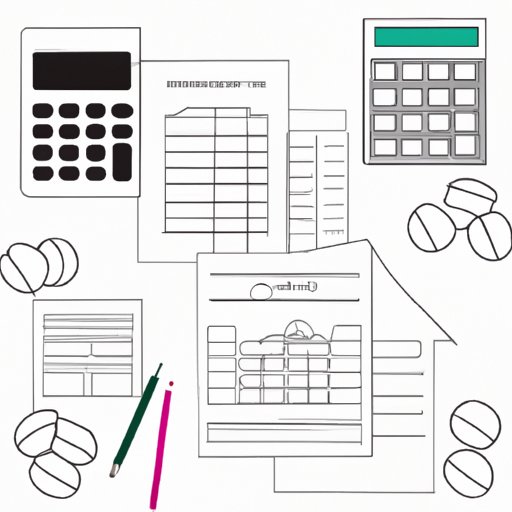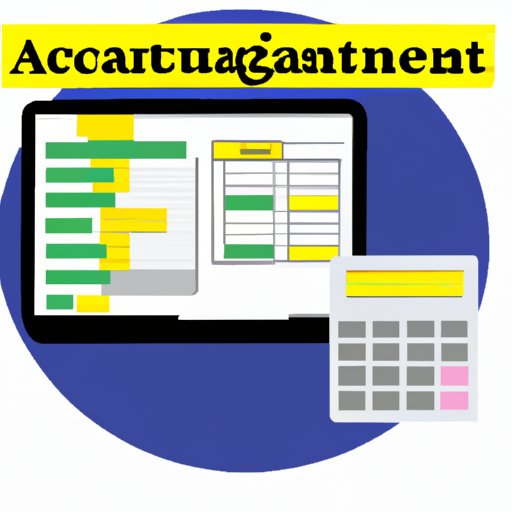Introduction
Having a comprehensive accounting system is essential for any successful small business. It provides valuable information about the financial health of your business and helps you make sound decisions that lead to growth. While starting an accounting system may seem overwhelming, this step-by-step guide will help you get started.

Outline the Basics of Accounting
Before diving into setting up an accounting system, it’s important to understand the basics of accounting. Accounting is the process of recording and analyzing financial transactions. It involves tracking income, expenses, assets, liabilities, and equity.
There are two main types of accounting: financial accounting and managerial accounting. Financial accounting focuses on providing financial statements to external stakeholders, such as investors and creditors. Managerial accounting focuses on providing internal financial reports to managers and owners for decision-making purposes.
Financial statements provide an overview of your company’s financial performance. The three main financial statements are the balance sheet, the income statement, and the statement of cash flows. The balance sheet shows the financial position of your business at a specific point in time. The income statement shows how much revenue your business has earned over a period of time. The statement of cash flows shows how much cash is coming in and out of your business.
Set Up a Chart of Accounts
The chart of accounts is a list of all the accounts in your accounting system. Each account is assigned a unique number for easy identification and categorization. Setting up a chart of accounts allows you to organize and track your financial data more efficiently.
When creating a chart of accounts, you’ll need to decide which categories of accounts you want to include. Common categories of accounts include assets, liabilities, equity, revenues, and expenses. You can also create subcategories within each category to further organize your financial data.
Once you’ve created your chart of accounts, you’ll need to assign a unique number to each account. This makes it easier to track and identify transactions. For example, if you have a revenue account for sales, you might assign it the number “1000.”
Determine How to Record Transactions
Now that you’ve set up your chart of accounts, it’s time to start recording transactions. To do this, you’ll need to determine which accounting method you want to use. The two main accounting methods are cash basis and accrual basis.
Under the cash basis method, you record transactions when cash is exchanged. This means that you only record income when you receive payment and expenses when you pay them. Under the accrual basis method, you record transactions when they occur, regardless of whether or not cash has been exchanged.
Regardless of the accounting method you choose, it’s important to accurately record all transactions. When recording transactions, it’s important to remember the basic principles of double-entry accounting. This means that every transaction must affect at least two accounts. For example, when you receive payment for a sale, you would record a debit to the cash account and a credit to the revenue account.
Choose an Accounting Method
Once you’ve determined how to record transactions, it’s time to choose an accounting method. As mentioned before, there are two main accounting methods: cash basis and accrual basis. Each method has its own advantages and disadvantages.
Under the cash basis method, income and expenses are recorded when cash is exchanged. This method is simpler to use and can be used by businesses with low turnover. However, it does not provide an accurate picture of your business’s financial performance since it does not take into account outstanding invoices or unpaid bills.
Under the accrual basis method, income and expenses are recorded when they occur, regardless of when cash is exchanged. This method provides a more accurate picture of your business’s financial performance. However, it is more complicated to use and requires more record-keeping.

Establish a System for Tracking Expenses
In addition to recording transactions, it’s important to establish a system for tracking expenses. Creating a budget is a great way to keep track of your expenses and ensure that you stay within your spending limits. You should also plan for future expenses to ensure that you have enough money to cover them.
There are also online tools available to help you track expenses. These tools allow you to easily categorize expenses, set budgets, and monitor your spending. They can also be used to generate detailed reports to help you better understand your financial data.
Utilize Automated Accounting Software
Automated accounting software can save you time and reduce the risk of errors. There are many different types of accounting software available, ranging from simple bookkeeping programs to sophisticated enterprise solutions. Before choosing a software package, you should consider your needs and budget.
Popular accounting software options include QuickBooks, FreshBooks, and Xero. These software packages offer features such as invoicing, expense tracking, and financial reporting. They can also be integrated with other applications, such as payroll systems, for added convenience.

Hire an Experienced Accountant or Bookkeeper
Finally, if you don’t feel confident setting up an accounting system yourself, you can always hire an experienced accountant or bookkeeper. An experienced professional can help you set up an effective system that meets your business’s specific needs.
When hiring an accountant or bookkeeper, look for someone who is knowledgeable and experienced. Ask questions about their qualifications and experience. Be sure to also ask about their fees and payment terms.
Conclusion
Starting an accounting system for your small business is an important step towards financial success. This guide has outlined the basics of setting up a chart of accounts, recording transactions, choosing an accounting method, tracking expenses, and utilizing automated accounting software. With the right guidance, you can create an efficient and effective accounting system.
(Note: Is this article not meeting your expectations? Do you have knowledge or insights to share? Unlock new opportunities and expand your reach by joining our authors team. Click Registration to join us and share your expertise with our readers.)
